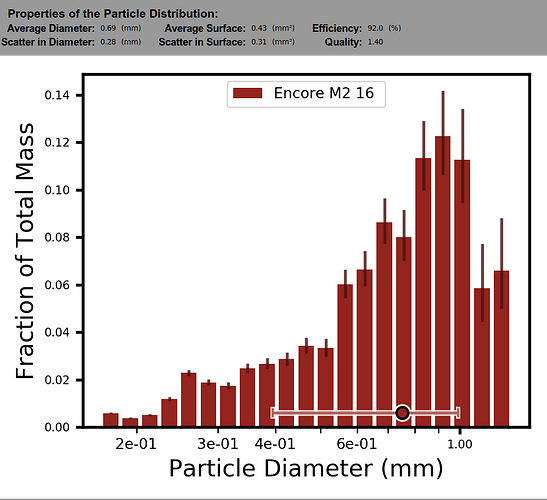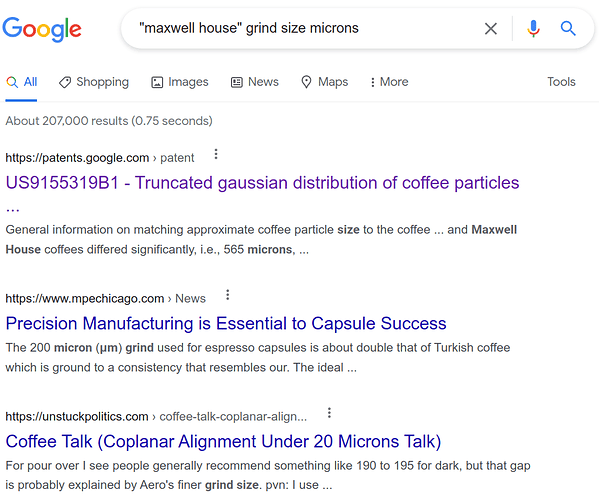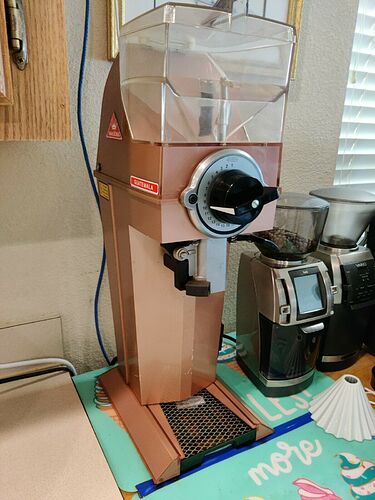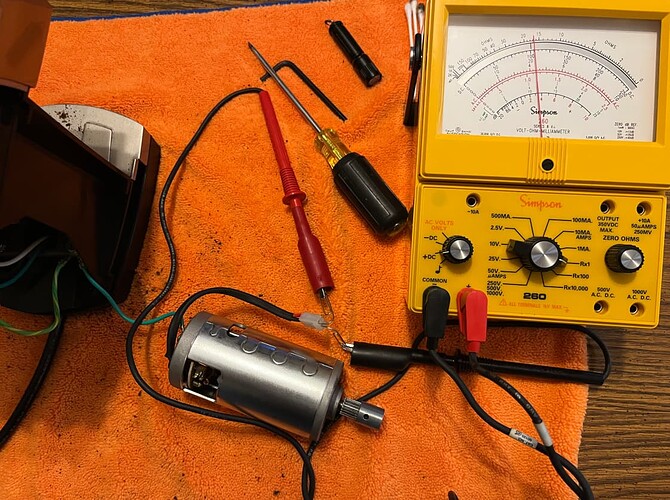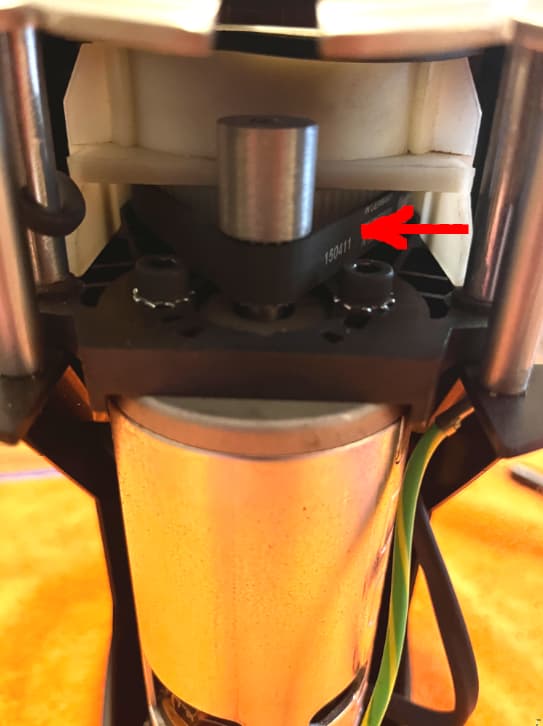What the fuck is this
I tried to improve my technique while grinding at a V60 size and noting taste. This is from my Encore with the M2 burr at setting 16. There was some slight bitterness but overall not bad, just not much flavor isolation at all.
I’ve selected different axes for this one compared to the previous version. That actually got me thinking, and there are quite a few ways you could analyze this. Particle Diameter vs. Fraction of Total Mass makes the most sense to me from a “separating the grinds with a sieve” standpoint, but that’s only one way to approach it. While this application is amazing, I’m not sure I like his handling of the statistics. Fortunately, it spits out a csv file of the raw data that you can analyze yourself. The software identified 2,427 particles in this tiny pinch of grinds I sprinkled onto the paper.
this is fucking sorcery
I’m into it
Here’s the source pic I used if you wanna test / calibrate to see if it’s firing correctly for you. I centered the coin in the shot to limit distortion, but then the software didn’t like that when I was choosing particle region so I photoshopped off into the corner. I also bumped the exposure but could have done better at getting more uniformity. Don’t select shadow or glare areas when you pick the region (it’s explained in the guides below).
There are two guides for using this: one is the short version, and one is the TLDR version, linked in that order. Lemme know if you have any issues getting it to run.
https://github.com/jgagneastro/coffeegrindsize/blob/master/Help/coffee_grind_size_manual.pdf
I’ve put about three pounds of coffee and a pound of rice through this Vario now. Feel like it needs a deep cleaning to get rid of this stuff though.
No clue what’s going on here. I brewed with 6M to match sizes and it tasted way worse than the Encore with more mud. The graph looks better but the grind quality is worse according to the app. I assume it’s due to the boulders. Dunno wtf is going on but all magic has been lost.
There’s a refurb Forte BG up for $735. Don’t see those too often.
Updated specs on the Crystal Geyser Alpine water:
Everything in PPM (mg/L) except pH. In terms of precision, alkalinity is the important one with the narrowest range. You will not see too many coffee water recipes deviating from 40 PPM much (+/- 10). How much this matters likely depends on the coffee though. The hardness, both by TDS and total hardness, have a considerably wider range. I consider the Ca/Mg hardness to be much less of a hard target and more of an active area of experimentation. SCAA assumptions are water is clear, odorless, and free of chlorine.
Mount Shasta appears to be the closest to spec without dilution followed by Olancha Peak. That’s good news for @EmpireMan and others who are likely to be sourced from there. The Norman, Benton, and Johnstown can get into range by dilution. However, I think the last two sources (Salem, Moltonborough) are probably useless as coffee waters because they’d require remineralization. Be sure to check your bottling source if you’re using these because mine switched from Norman to Johnstown somewhat recently.
I found the reports here:
in other grinding news, I am going to try out that distribution software this weekend, but I am feeling pretty good that I’m still in alignment now. just opened a new bag (brazillian catuai) and the first cup at 9P looked perfect. virtually no fines on the sides of the cone, great looking bed, everything looked uniform, just under 4:00 brew time (with a tabbed hario filter). Great flavor, super clean, A+.
I’m not going to avoid Ethiopian/kenyan beans, I’ve had some amazing cups and the variation is part of the excitement I suppose, but I’ve had much, much more consistent experiences with new world beans.
Been brewing some decent cups since hyper-aligning. I hyper-aligned and ran 3lb of junk beans through and have had a few solid bags now. After hyper aligning I fired up the Gagne program and took at look at the distribution on all my grinders. I screwed up and didn’t normalize the settings on them sufficiently but it was pretty obvious that my Virtuoso made a lot of boulders while the ode and forte both performed well. The forte specifically was putting out distributions on par with the home grinder that was compared in Hoffman’s crazy industrial grinder video. After that I stopped messing so much with the grinder and started playing with brew methods.
I think in addition to producing some fines before, I was just grinding too fine overall. My forte is still zeroed at 2Q and I’ve been grinding at around 9M.
Other things that have helped is I’ve ditched Hoffman’s methods. The 4:6 method and Lance Hedricks method have both been quite effective for me.
I’m on board for zeroing at 1M so we can compare notes more easily. I’ll try and do that tomorrow
this is essentially where I’ve settled.
As for method, I’m not really sure the method makes that much difference, my feeling is any Rao/Hoffman/Hedrick/Kasuya etc can all turn out equally good cups, you just might dial in a different grind for each of them. I do occasionally change it up but I basically have settled on this, mostly because the ratios are easy to do in my head
- 15g grinds
- 2-3x bloom (putting a divot in the bed with my pinky makes a 2x wetting possible) 45s
- slow pour to a total of 10x, swirl gently
- drain completely
- slow pour to a total of 17x, swirl gently
- don’t pay attention to the clock other than to note how long it took afterwards (e.g. instructions like “2nd pour at 2:00” are dumb and useless)
the problem with recipies that go by ratios is (IMO) they make people think “oh, I dialed this in with 15g, now I can just scale everything up 2x” and I feel like this is just absolutely wrong (don’t really have my own data on this because I just rarely make a bigger brew than 15g). It just feels like the water speed etc dictates that the results at a given grind size at 30g is necessarily going to be significantly different than at 15g for the same grind with a given bean.
Brewing 30g at a time is somewhat attractive from an effort point of view, but this would probably lead to me having more sub-par coffee overall using 30g at a time to dial it in and it would also lead to me drinking more coffee, which I don’t really want right now (currently drinking 2-3 15g cups/day and I feel like that’s plenty).
In awe at the size of this lad
It’s way bigger than I thought, although that’s an older model and the newer one looks smaller. I think my next grinder will be one of these commercial jobs though. I was in a restaurant liquidation auction recently but ultimately passed on a KR1203 (they’re $5600 new but there are a lot of them floating around out there from the Borders liquidation). It’s 36" tall and weighs 88 pounds, and while I’m sure the grind is amazing, I think I’d rather pay up for a somewhat more manageable EK, KR804, or possibly Guatemala/Tanzania if the price is right.
My best cups usually result from pouring all of the water in quickly for maximum plunge at 15:1 ratio with a 9A / 1M calibration. Not sure why or how, but that’s the only way I tend to get really juicy acidity with sweetness and balance.
Which water are you using now?
Also, I should point out another problem with the Lamborghini-class grinders and why it doesn’t really make sense to own them for home. The parts cost on the commercial / shop quality machines are insane. For example, the motor for a Mahlkonig or Ditting will cost somewhere in the range of a new Vario or Forte. The power switch for the EK43 is $150. You really need the thing to not break, which is fortunately what they’re built to not do.
Also in this class are what I’d call low-production-run boutique grinders like the Weber EG-1. My understanding is that you also really need these to not break because you may not get service. I was reading something recently where a person had a problem with one of these and the response was basically “too bad.” Who knows if you could even get parts for them of if the companies will be around in five years.
yeah that’s the main thing that concerns me when looking at this sort of stuff. there are a dizzying number of $3000+ grinders from companies that didn’t exist a year ago. No way I’m rolling those dice.
May have solved my grind quality issue. I finally did a tear down for inspection to check the major stuff like motor and integrity of the internal parts. If you aren’t removing the upper housing and grind chamber, it’s actually really easy to work on these. You just take the two back feet and screws out and slide the case straight off, giving you access to the inside. From there it’s pretty easy to drop out the motor, belt, drive gear, and lower burr carrier. I could easily replace all of those in under 30 minutes.
Here’s a motor test for reference. You can see that I just dropped it out and didn’t even disconnect the ground wires (green) from the machine. Hook up the meter and then look for resistance as you slowly rotate the motor shaft through all of the pole positions. Each pole should give a reading in about the same range, and here you can see it’s about 17 ohms. If any of the poles read zero/continuity/inf, it’s broke and you need to replace the motor.
Nothing was broken or in obvious disrepair. The thing I noticed was this:
That’s the drive belt. It should be tight enough that it only flexes about 2mm when you push where the red arrow is pointing with a decent amount of force. Mine was flexing considerably more than that. I inspected the teeth for flat spots but it looked fine, so really just a tension issue. I can also hear the difference when the motor is running and it sounds more consistent with less of a cycle / wobble.
Check out those two hex screws flanking the belt to the left and right. Those are the motor mounts, and the left one sits in window allowing you to move it forward or backward to adjust the tension on the belt. There’s nothing stopping the belt from pulling it forward over time other than the amount of torque you apply screwing it down, so easy to imagine it could drift slightly toward the front of the machine over time resulting in lower tension.
Sealed it back up and put a few different beans through. It seemed to grind faster and the ultra fine powder appeared to be greatly reduced. Didn’t pour a V60 so don’t know for sure yet though.
Still using distilled water with third wave packets mixed in. Been doing that for at least a few months. Actually the last couple days I had to use filtered tap while waiting on more packets and I can tell a difference in flavor
[Edit: I had written that there is conflicting information about whether TWW classic profile has any buffer at all. Early versions of the TWW site claim there is no buffer, but I had forgotten that Gagne did the chemistry math for it / checked with the strips, and both the predicted / actual values are close enough to SCA target. It still seems to be a bit hard compared to other recipes people recommend.]
V60 was still muddy but not quite as bad. The coffee was better with reduced sourness and bitterness but not quite where it should be. I probably lost my alignment with all of the tinkering so I’ll have to check it again. I’ll also recheck the belt tension to make sure it’s holding. Note: I have one of the oldest Varios from before they made changes to a lot of internal parts. The rest of you have the new stuff with all of the upgraded components. My plan was to order the parts and do the rebuild, but I’m strongly considering a straight upgrade to commercial instead.
